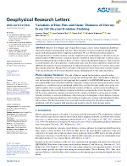Variations of Heat Flux and Elastic Thickness of Mercury From 3-D Thermal Evolution Modeling

Author
Fleury, Aymeric
Plesa, Ana-Catalina
Tosi, Nicola
Publication date
2024Published in
Geophysical Research LettersVolume / Issue
51 (21)ISBN / ISSN
ISSN: 0094-8276ISBN / ISSN
eISSN: 1944-8007Metadata
Show full item recordCollections
This publication has a published version with DOI 10.1029/2024GL110622
Abstract
Mercury's low obliquity and 3:2 spin-orbit resonance create a surface temperature distribution with large latitudinal and longitudinal variations. These propagate via thermal conduction through the thin silicate shell influencing the interior temperature distribution. We use 3-D thermal evolution models to investigate the effects of lateral variations of surface temperature and crustal thickness on the surface and core-mantle boundary (CMB) heat fluxes, and elastic thickness distribution. Surface temperature variations cause a long-wavelength perturbation of the heat fluxes, as well as of the elastic lithosphere thickness, while variations in crustal thickness affect these quantities at small spatial scales. Like the surface temperature, the present-day CMB heat flux pattern is characterized primarily by spherical harmonics of degrees two and four, which could affect dynamo generation. Placing robust constraints on the thermal evolution based on the available estimates of the age and thickness of the elastic lithosphere remains challenging due to their large uncertainties.
Keywords
mercury, heat flux, elastic lithosphere thickness, thermal evolution, crustal thickness, surface temperature,
Permanent link
https://hdl.handle.net/20.500.14178/2897License
Full text of this result is licensed under: Creative Commons Uveďte původ 4.0 International






